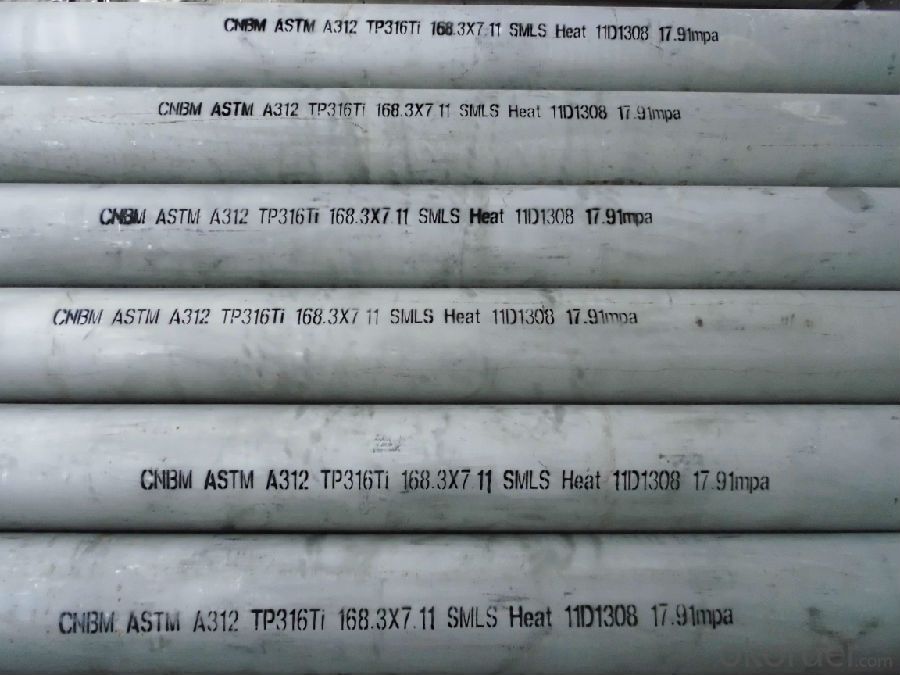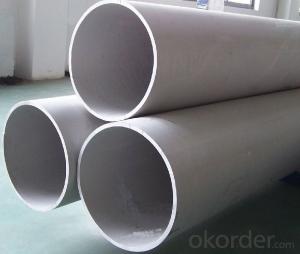Seamless tube316Ti 10
- Loading Port:
- China Main Port
- Payment Terms:
- TT OR LC
- Min Order Qty:
- -
- Supply Capability:
- -
OKorder Service Pledge
Quality Product, Order Online Tracking, Timely Delivery
OKorder Financial Service
Credit Rating, Credit Services, Credit Purchasing
You Might Also Like
316Ti stainless steel plate is the addition of Ti in SUS316 steel can improve the resistance to intergranular corrosion resistance.


The chemical composition of 316Ti stainless steel:
C (%): less than 0.08
Si (%): less than 1
Mn (%): less than 2
P (%) is less than or equal to: 0.045
S (%) is less than or equal to 0.03
Cr (%): 16 ~ 18
Ni (%): 10 ~ 14
Mo (%): 2 ~ 3
other (%):
5 (C+N) = Ti = 0.70, N = 0.10
The mechanical properties of 316Ti stainless steel:
YS (Mpa) = 205 TS (Mpa) = 520 EL (%) is more than or equal to 40 Hv 200 degrees
- Q:Can stainless steel pipes be used for high-pressure applications?
- Indeed, high-pressure applications can utilize stainless steel pipes. Renowned for their exceptional corrosion resistance, strength, and durability, stainless steel proves to be a fitting choice for managing high-pressure fluids or gases. Without succumbing to deformation or leakage, stainless steel pipes endure immense pressures, guaranteeing the secure and effective transportation of fluids across diverse industries such as oil and gas, chemical processing, and power generation. Moreover, their ability to withstand extreme temperatures further amplifies their aptness for high-pressure applications.
- Q:Are stainless steel pipes resistant to pitting and crevice corrosion?
- Yes, stainless steel pipes are highly resistant to pitting and crevice corrosion. This is due to the presence of a protective layer of chromium oxide on the surface of the steel, which forms a barrier against corrosive elements. This layer is self-healing, meaning that even if it gets damaged, it will regenerate quickly, ensuring continued corrosion resistance. Stainless steel pipes are commonly used in various industries that deal with corrosive substances, such as the chemical, oil and gas, and food processing industries, where the pipes are exposed to aggressive environments. Overall, stainless steel pipes are a reliable choice for applications where corrosion resistance is a critical requirement.
- Q:Are stainless steel pipes suitable for automotive exhaust systems?
- Yes, stainless steel pipes are suitable for automotive exhaust systems. Stainless steel is a popular choice for exhaust systems due to its excellent resistance to corrosion and high temperatures. It can withstand the harsh conditions of an exhaust system, including exposure to moisture, heat, and chemicals. Stainless steel pipes also have good strength and durability, ensuring they can withstand the vibrations and pressure fluctuations within the exhaust system. Additionally, stainless steel pipes are known for their aesthetic appeal and can enhance the overall look of the vehicle. Overall, stainless steel pipes are a reliable and long-lasting option for automotive exhaust systems.
- Q:304 stainless steel will rust it?
- Why is stainless steel rust? When the stainless steel tube surface appear brown rust (point) when people are surprised: "the stainless steel does not rust, rust is stainless steel, steel may be a problem". In fact, this is a lack of understanding of stainless steel one-sided misconceptions. Stainless steel will rust under certain conditions.
- Q:What is the difference between seamless and hot-expanded stainless steel pipes?
- The main difference between seamless and hot-expanded stainless steel pipes lies in their manufacturing processes. Seamless pipes are created by piercing a solid billet of stainless steel, while hot-expanded pipes are made by expanding a hollow tube while it is heated. This process results in a larger diameter and thinner wall thickness compared to seamless pipes. Additionally, hot-expanding allows for a wider range of sizes and shapes to be produced.
- Q:304 stainless steel has several advantages, a few big advantages, the more concrete the better
- 304 stainless steel has excellent stainless steel corrosion resistance and better intergranular corrosion resistance. The oxidizing acid, in the experiments: the concentration of more than 65% of boiling temperature following nitrate, 304 stainless steel has high corrosion resistance. Alkaline solution and most organic acids and inorganic acids also have good corrosion resistance.
- Q:How do you calculate the flow velocity in stainless steel pipes?
- In order to determine the flow velocity in stainless steel pipes, one must take into account multiple factors. Firstly, it is necessary to be acquainted with the flow rate or volumetric flow rate (Q) of the fluid that passes through the pipe. This can be ascertained by measuring the volume of fluid that traverses the pipe within a given time period. Subsequently, the cross-sectional area (A) of the pipe needs to be determined. For circular pipes, this can be computed using the formula A = πr², where r denotes the radius of the pipe. Once both the flow rate (Q) and cross-sectional area (A) are known, the flow velocity (V) can be calculated using the formula V = Q / A. It is worth noting that the flow velocity may undergo variations along the length of the pipe due to factors such as friction and changes in pipe diameter. In such instances, more advanced calculations or simulations may be required to accurately ascertain the flow velocity at specific points within the pipe. Furthermore, it is crucial to take into consideration the properties of the fluid being transported, such as viscosity and density, as they can also impact the flow velocity.
- Q:What's the easiest way to distinguish between stainless steel 202 and 304?
- Not bad money to use 304 of the durability, a few years later, if the price increases, maybe scrap can sell back the cost of moneyIdentification: the only way for you is to go to Taobao to buy potions and estimate where your hardware parts might be soldOther methods are not good, the naked eye can not tell, we are not able to distinguish between the industry are relying on syrup202 can also be used but a guarantee and profiteers will give you for 201 anyway you do not201 did not rust for 2-3 years
- Q:Can stainless steel pipes be used for petrochemical applications?
- Certainly, petrochemical applications can make use of stainless steel pipes. The utilization of stainless steel pipes proves advantageous due to their exceptional resistance to corrosion and high temperatures, which are prevalent in the handling and transportation of diverse corrosive and high-temperature substances during petrochemical processes. Stainless steel is renowned for its capability to endure aggressive chemicals, including acids and alkalis, while also demonstrating resistance to stress corrosion cracking. Furthermore, stainless steel pipes exhibit remarkable durability and possess a prolonged lifespan, rendering them well-suited for the challenging conditions encountered in petrochemical applications.
- Q:How do you prevent oxidation in stainless steel pipes?
- There are several methods to prevent oxidation in stainless steel pipes. One effective way is to apply a protective coating or finish on the surface of the pipes. This can be done using various types of coatings such as paints, epoxy, or polyurethane. These coatings act as a barrier, preventing oxygen from coming into contact with the stainless steel and therefore reducing the chances of oxidation. Additionally, regular cleaning and maintenance of the pipes is crucial in preventing oxidation. It is important to remove any dirt, debris, or corrosive substances that may have accumulated on the surface of the pipes. This can be done using mild detergents or specialized cleaning agents specifically designed for stainless steel. Another preventive measure is to ensure proper ventilation in the area where the stainless steel pipes are installed. Adequate ventilation helps to minimize the presence of moisture or humidity, which can accelerate the oxidation process. Additionally, keeping the pipes dry and avoiding prolonged exposure to water or moisture is essential in preventing oxidation. Lastly, it is important to select the appropriate grade of stainless steel for the intended application. Different grades of stainless steel offer varying levels of resistance to oxidation. For example, austenitic stainless steel grades such as 304 and 316 are highly resistant to oxidation and are commonly used in applications where corrosion resistance is crucial. Overall, a combination of preventive measures such as protective coatings, regular cleaning, proper ventilation, and selecting the appropriate stainless steel grade can help effectively prevent oxidation in stainless steel pipes.
1. Manufacturer Overview |
|
|---|---|
| Location | |
| Year Established | |
| Annual Output Value | |
| Main Markets | |
| Company Certifications | |
2. Manufacturer Certificates |
|
|---|---|
| a) Certification Name | |
| Range | |
| Reference | |
| Validity Period | |
3. Manufacturer Capability |
|
|---|---|
| a)Trade Capacity | |
| Nearest Port | |
| Export Percentage | |
| No.of Employees in Trade Department | |
| Language Spoken: | |
| b)Factory Information | |
| Factory Size: | |
| No. of Production Lines | |
| Contract Manufacturing | |
| Product Price Range | |
Send your message to us
Seamless tube316Ti 10
- Loading Port:
- China Main Port
- Payment Terms:
- TT OR LC
- Min Order Qty:
- -
- Supply Capability:
- -
OKorder Service Pledge
Quality Product, Order Online Tracking, Timely Delivery
OKorder Financial Service
Credit Rating, Credit Services, Credit Purchasing
Similar products
New products
Hot products
Related keywords



























